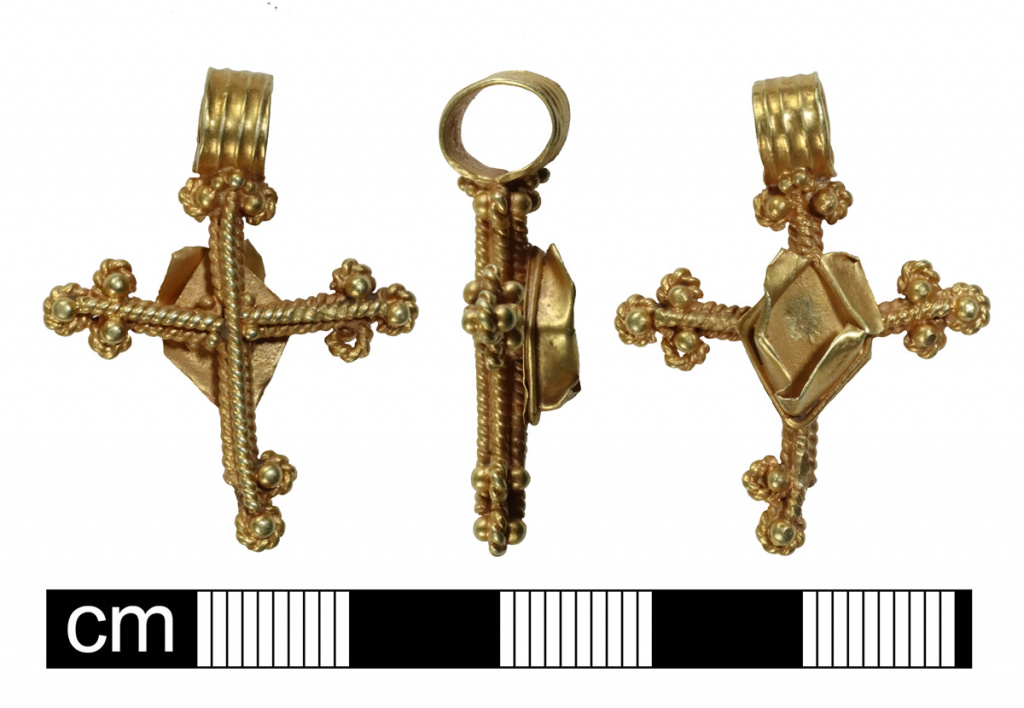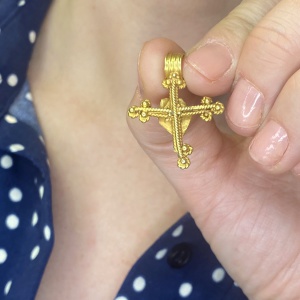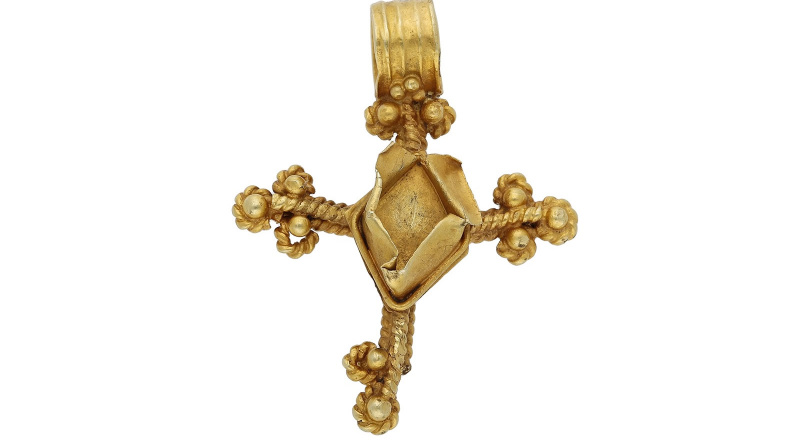Throckenholt Cross sold for £10,000
The Throckenholt Cross is a detecting find from 2019. DNW sold it in their auction on 15 March 2022 for a hammer price of £10,000 (£12,400 including buyer’s premium). It had been estimated to fetch £6,000-8,000, and after competition on the internet and telephones, it was bought by a private collector via the telephone.
The finder, Jason Wills, said after the sale “I am a roofer and I was working today, so I watched the sale over my phone while sat on a roof! I am over the moon and as I have just moved house, the money will go towards new items for the house.“
The Find
Jason found the cross on 31 March 2019. Jason goes out detecting with his eight friends each Sunday in all weather conditions. On this Sunday he was detecting in a field in Sutton St Edmund, Lincolnshire. After getting a signal on his Minelab Etrac he dug down a few inches and spotted something that looked interesting. After washing off the mud, he realised he was holding a tiny golden cross.

Mark said “My friends and I have had some good finds over the years, but when I came upon the cross and washed it off, I knew it was something special and by the shining yellow-colour, I knew it was gold!“
The find was recorded at the PAS as NMS-06E591 went through the treasure process and was then disclaimed.
Sutton St Edmund
Nigel Mills, Consultant (Artefacts and Antiquities) at Dix Noonan Webb added: “The parish of Sutton St. Edmund, where the cross was found, includes the hamlet of Throckenholt, where a hermitage and chapel were granted to Thorney Abbey, by Nigel, Bishop of Ely (1133-69) in the 12th century. It is probable that there had been a hermitage here for some time; the Red Book of Thorney states that Throckenholt had been used as a hermitage since 1107.
The hermitage is mentioned again in 1189-97 and in 1348. Between 1293-1305, records show that Abbot Odo of Thorney ordered that 2 or 3 monks should reside there, as had previously been the case. The chapel stood where Throckenholt farmhouse now stands: fragments of stone, bones and other relics have been found on this site at various times. It survived until at least 1540 when it is shown on a map of Wisbech hundred (the original is in Wisbech Museum).”
The Throckenholt Cross

The gold cross pendant is believed to date to the 11th-12th century and is 31mm in length
Hanseatic League
Frances Noble, Head of the Jewellery Department and Associate Director at DNW, provides some historical background:
“This pendant is of a form associated with Medieval Greek Othodoxy in the Eastern Baltic region and a very similar example was discovered in Denmark. In the medieval period, Denmark formed part of the Hanseatic League, a commercial and defensive alliance of merchant guilds and market towns in central and northern Europe, growing from a few north German towns in the late 12th century, to over 200 towns at the height of its powers between the 13th and 15th centuries. At its peak, the Hanseatic League had a virtual monopoly over maritime trade in the North and Baltic seas. King’s Lynn, on the North Norfolk coast, just 20 miles from Sutton St Edmund, was a significant trading partner for the Hanseatic League, and this trade link may provide a possible explanation for these two very similar cross pendants”.
DNW Auction
The finder, Mark, said “I saw that Dix Noonan Webb were having a Valuation Day in Norwich, so I took it along. I am just about to move house, so the money from the sale of the cross, will be put towards that“
The Throckenholt Cross was Lot 103 in DNW’s auction of Jewellery, watches and Objects of Vertu on 15 March 2022.

